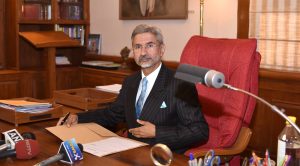Mohamed Zeeshan

Amidst the chaos of unfolding events in Afghanistan, India has floundered. Its approach to the crisis in Afghanistan has been characterized by incoherence and inconsistency.
There was reasonably long time-lag between former U.S. President Donald Trump’s deal with the Taliban, which paved the way for the exit of U.S troops from Afghanistan, and the eventual pullout of troops.
Yet, India was caught unprepared.
After having been shut out of early dialogue under Trump, India has been deeply unsure of how to approach the Taliban.
As late as the end of June, India seemed reluctant to recognize the reality on the ground. It took pains to contradict Qatari authorities, who claimed that India’s Minister for External Affairs, S. Jaishankar had met Taliban leaders in Doha. India’s position at the time was that the Taliban was not a legitimate stakeholder, even as the balance of power was tilting firmly in its favor.
But only two months later, when that policy became so obviously unsustainable, New Delhi had to change tack and publicly establish official dialogue with the group’s leadership.
Then, when the Taliban stormed into Kabul on August 15, India evacuated its embassy, leaving little to no support on the ground for hundreds of Indians who were still trapped in Afghanistan. At one point, some 150 Indians were held back from their evacuation flight by Taliban fighters.
But perhaps the worst of India’s policy quagmires concerned visas for desperate Afghans fleeing their country. After initially rolling out emergency visas for them, New Delhi arbitrarily cancelled those issued visas and launched a new e-visa scheme. Yet, few e-visas appear to have been granted since then under the new scheme. The policy flip-flop has cost India significant goodwill among exasperated Afghan citizens.
Meanwhile, critics have also panned India’s inaction on extending humanitarian aid to Afghans.
It shouldn’t have been like this.
As shocking as it was, the Taliban’s takeover was not entirely unexpected. For well over a year, several commentators had been predicting that the Taliban would capture power. If it had undertaken any scenario planning, New Delhi would have seen this coming and should have been prepared for it. And if New Delhi had been prepared, there would not have been any flip-flops in policy or overly delayed action. Instead, it chose to wait and watch.
A large part of the problem here is that the Indian government does not have an institutionalized mechanism to do such scenario planning – the act of gaming situations, anticipating possible scenarios, and coming up with policy options for different scenarios well ahead of time.
The Indian Ministry of External Affairs (MEA) has a Policy Planning and Research Division, but former diplomats told me that scenario planning is essentially fragmented and undertaken at the Joint Secretary level. In the absence of a dedicated team, such scenario planning is done only if initiative is taken at the highest level during a crisis, a former Indian foreign secretary said.
But given that foreign policy is now a multi-dimensional matter, scenario planning will have to involve far more stakeholders than just the MEA. In India, visa policy, for instance, is handled by the Ministry of Home Affairs and not the MEA.
That problem is seemingly solved by the National Security Council (NSC), which brings all the major cabinet ministers together alongside the prime minister and the national security adviser. The NSC also has its own Strategic Planning Group (SPG), which is composed of the highest-ranking bureaucrats from various ministries.
Yet, by their very composition, the NSC and its constituent committees can only react to crises once it begins unfolding, rather than proactively plan for different scenarios before the crisis erupts: All or most of their members are high-level decision-makers with a full plate of responsibilities elsewhere.
The NSC should be supported by a dedicated, full-time institution which undertakes scenario-planning responsibilities, anticipating situations well in advance and presenting a menu of policy options to, both, shape the evolving crisis as well as prepare for the worst.
In the absence of such mechanisms, India’s default position in foreign policy has been to wait and watch as situations evolve. But as time passes during a crisis, options and space for favorable action often decreases, leaving New Delhi to play catch-up to secure its interests. Worse, India also becomes less able to proactively shape situations – a key necessity in the quest to build global influence.
Influential powers are often countries that are able to dictate the course of events at crucial points in time, before it’s all too late.
India has long aspired to play a bigger role in world affairs – as an influential power that shapes events, rather than as one which is forced to react to them as they happen. New Delhi has long been exasperated at being forced to conduct last-gasp evacuation operations when its people are caught in the crossfire on the battlefield. It wants instead to have a voice which shapes situations before they get out of hand.
The starting point to building that capability is scenario planning. It’s time for India to institutionalize scenario planning in its foreign policy.
No comments:
Post a Comment